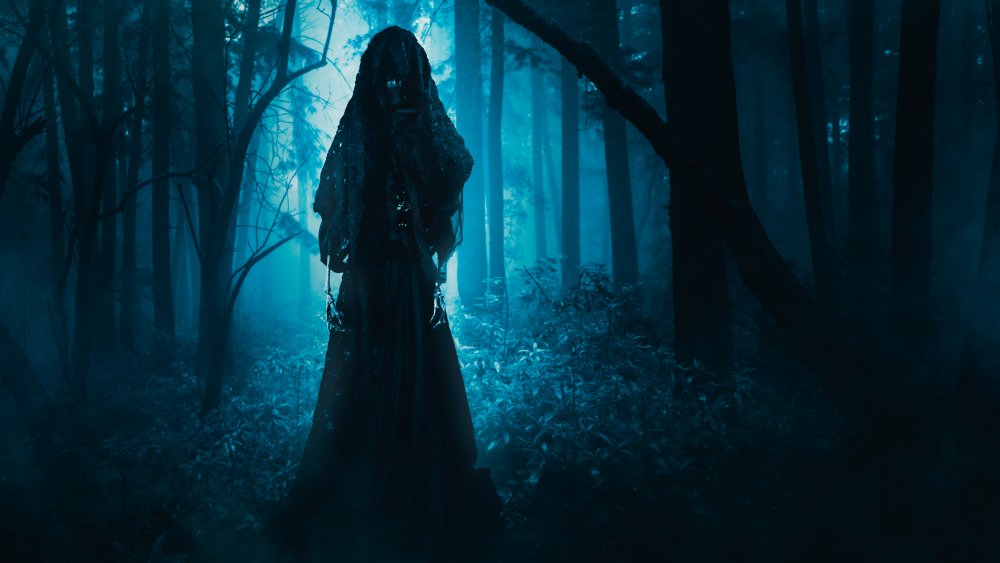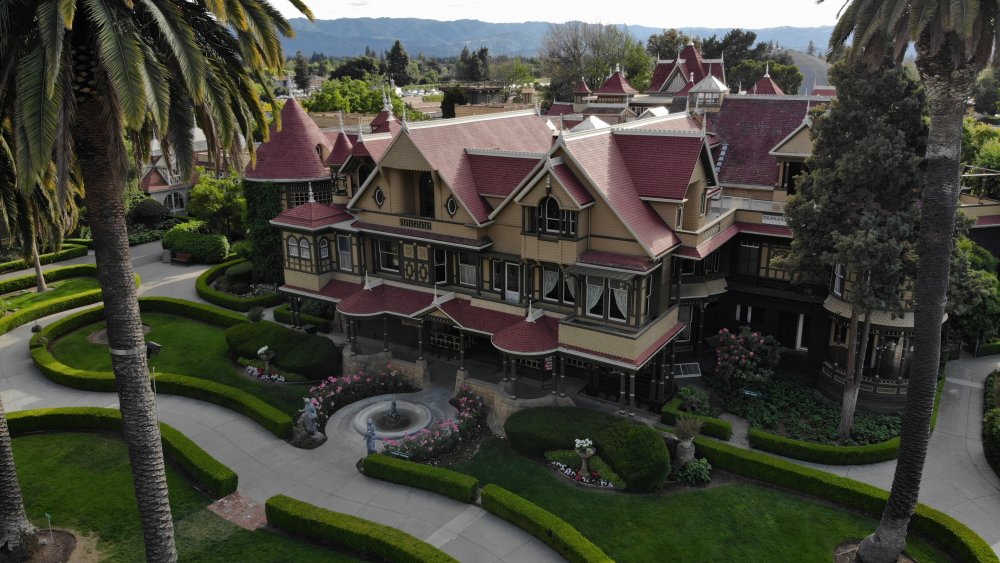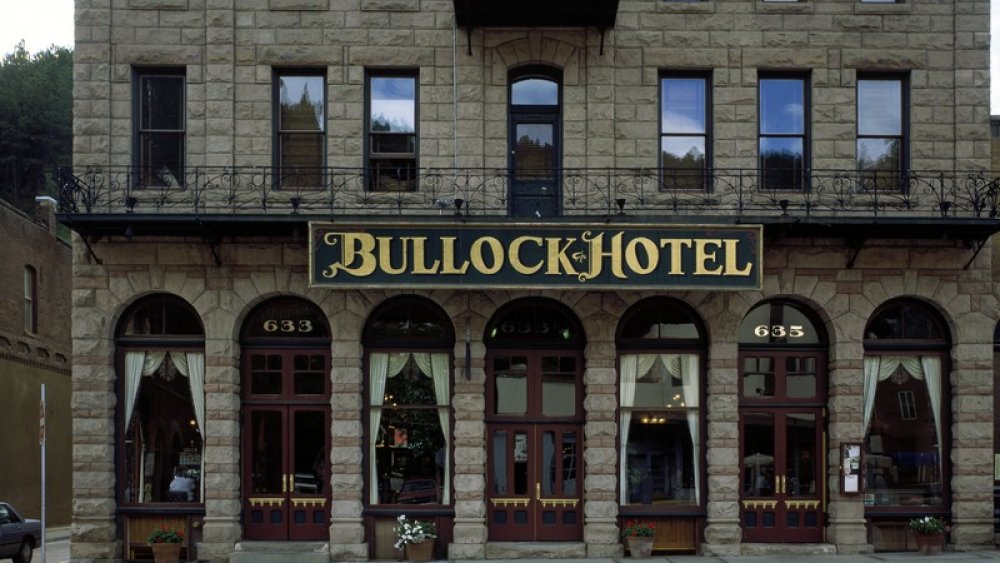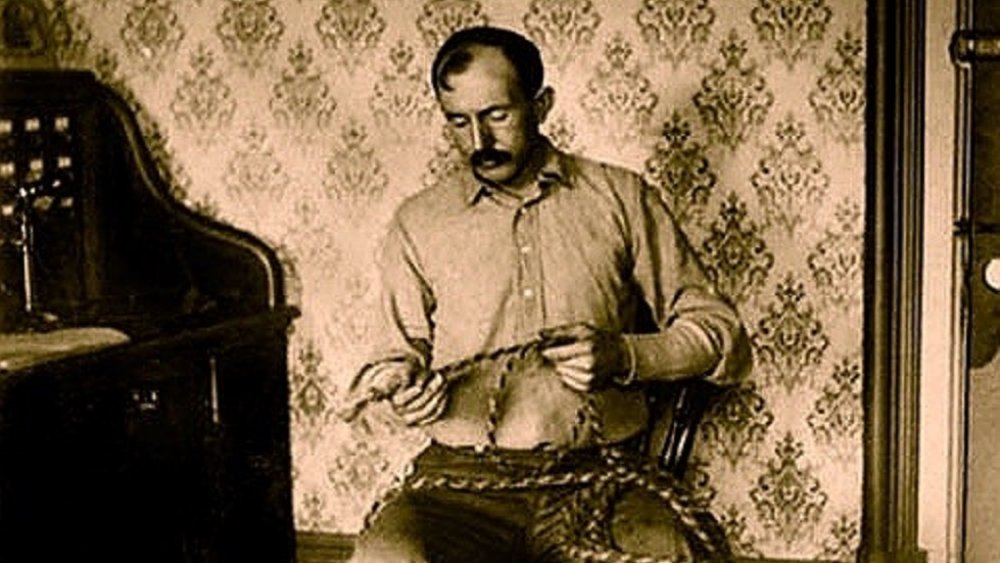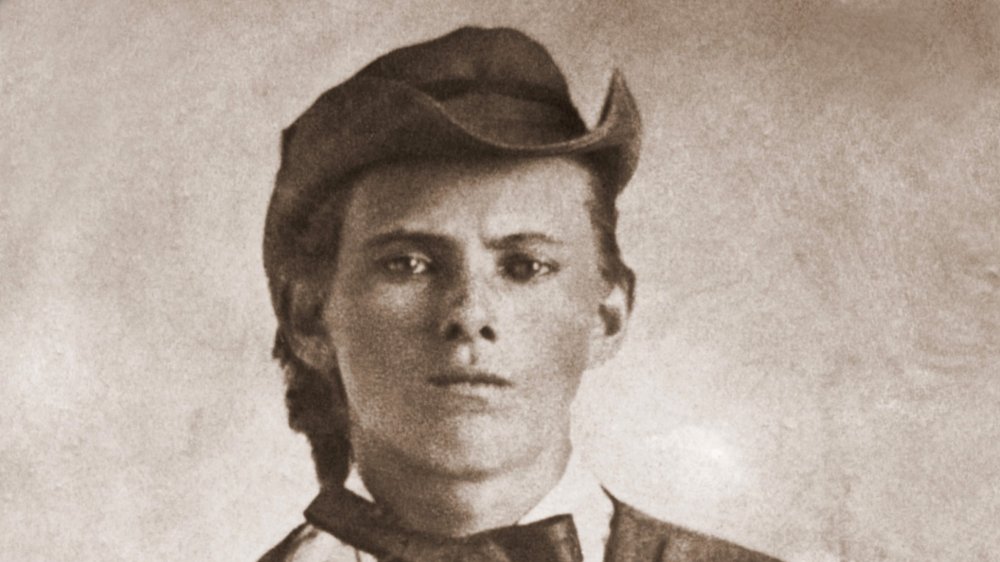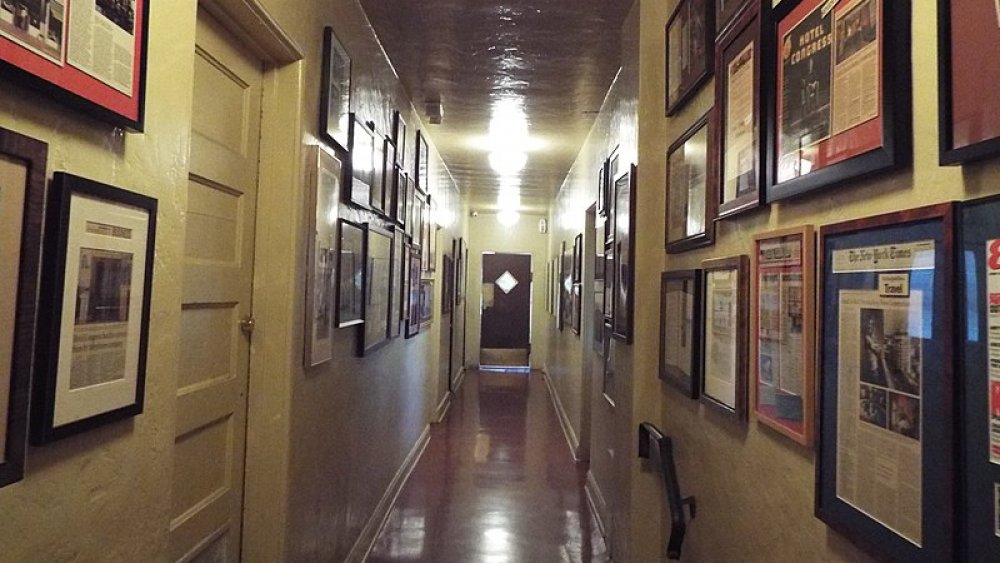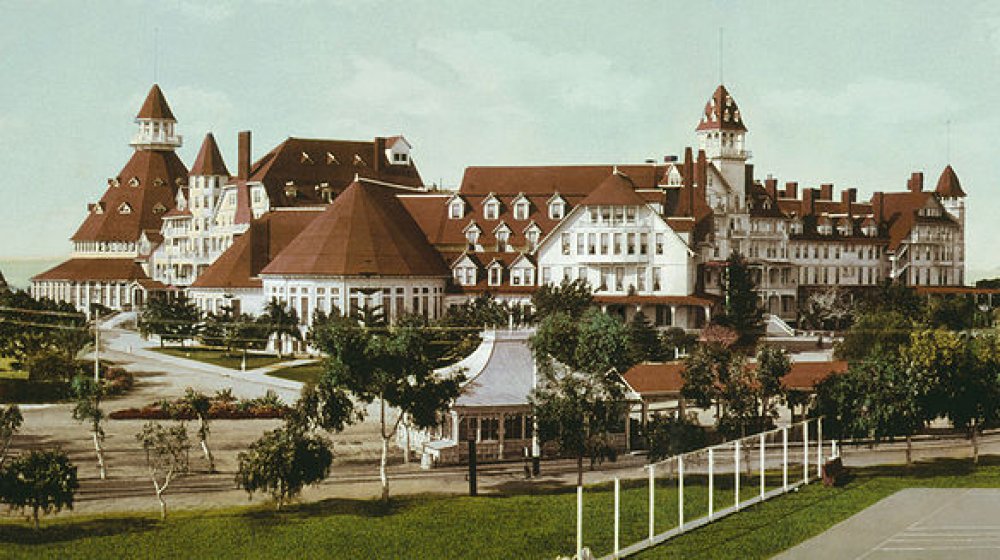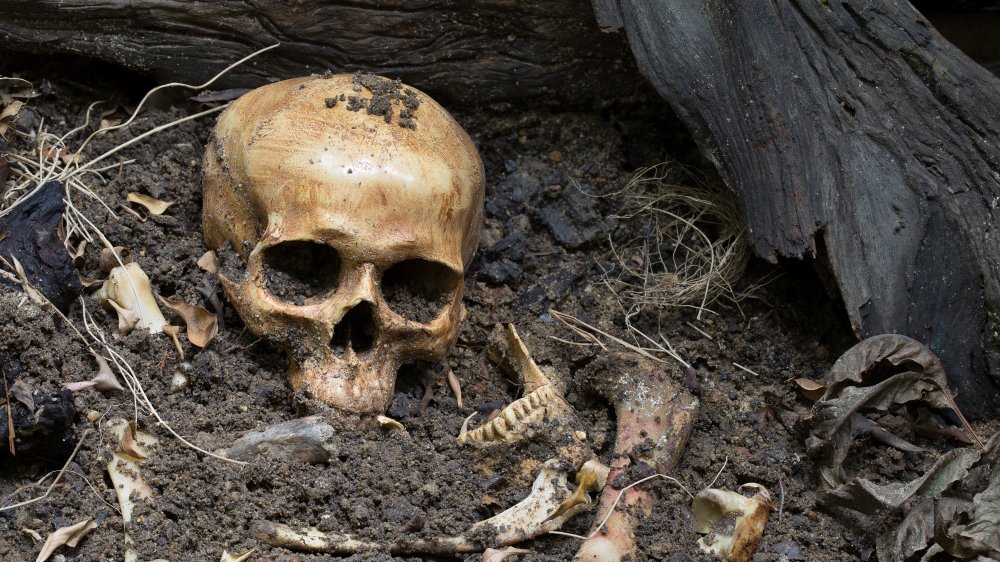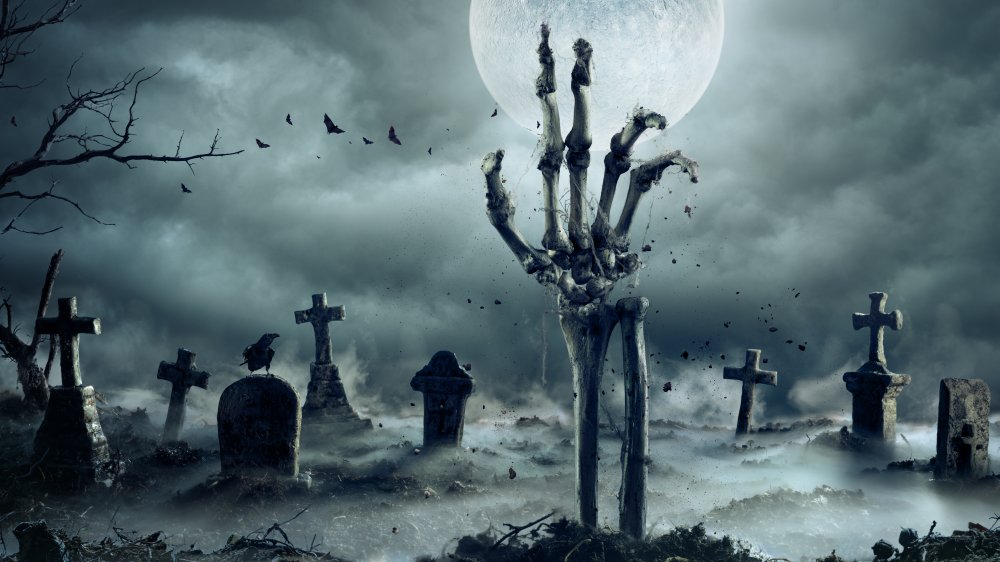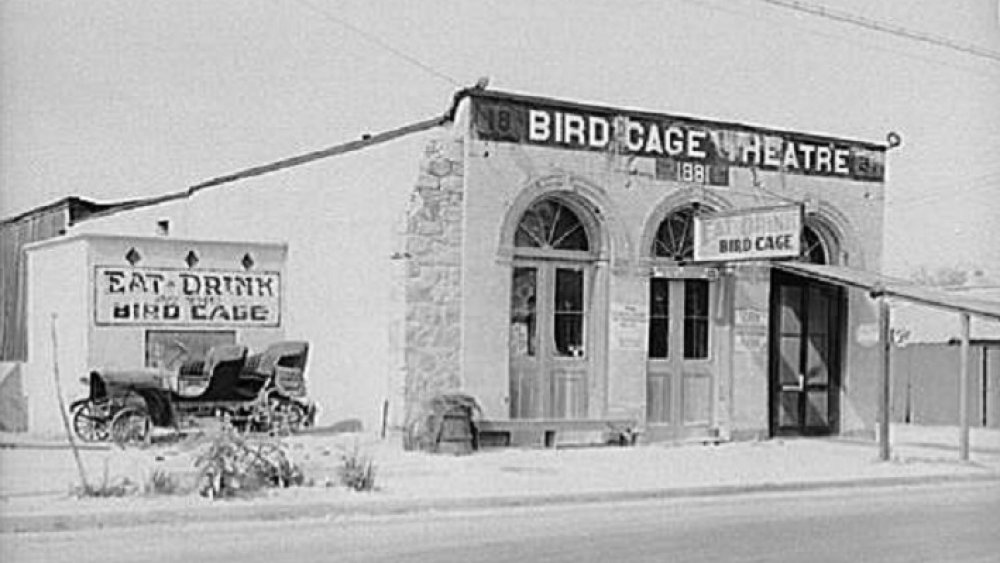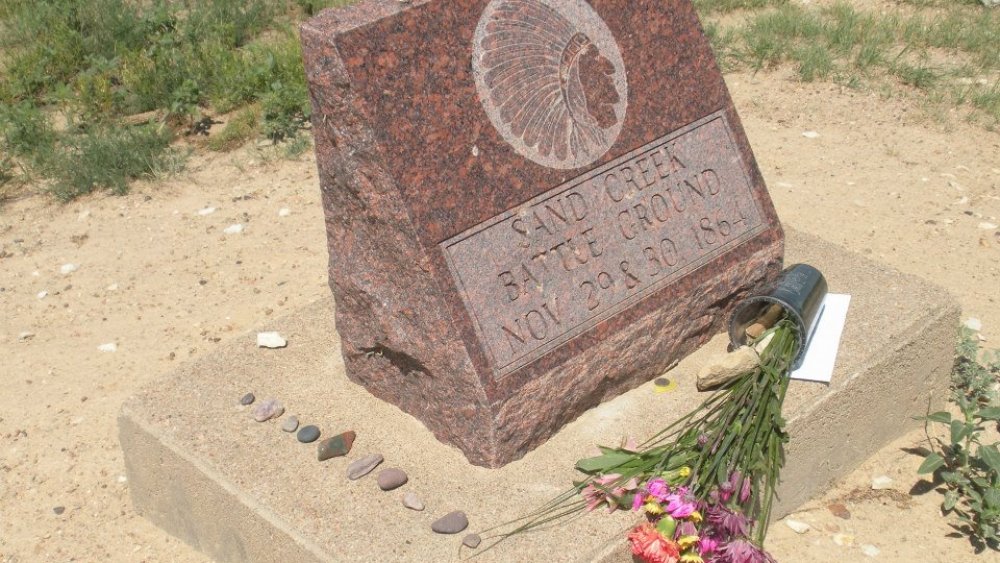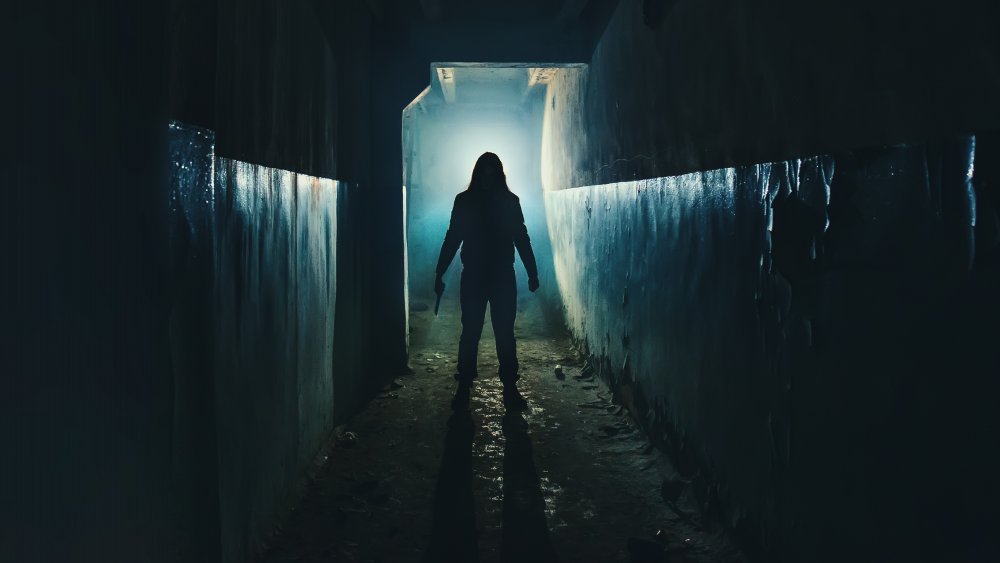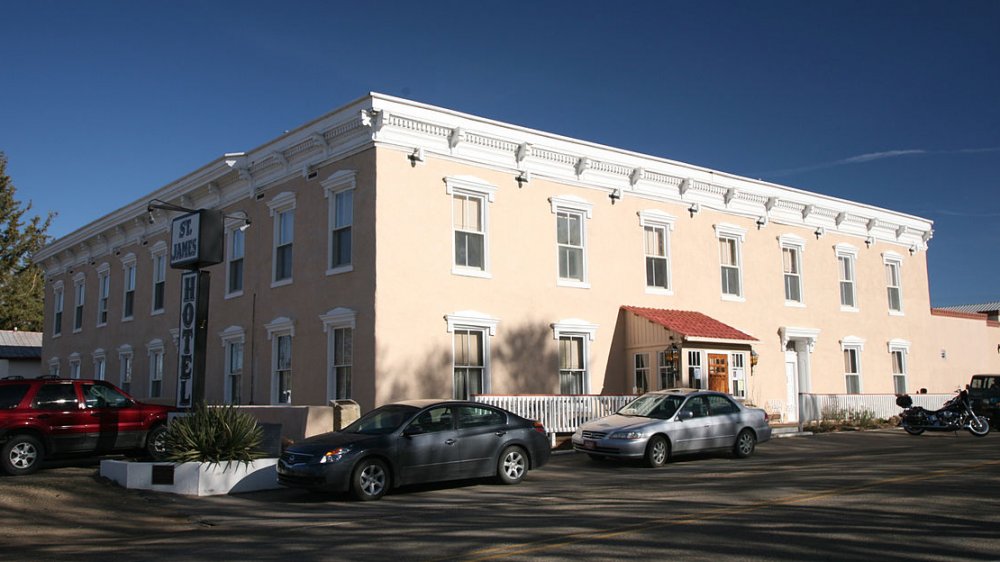Creepy Tales Of Wild West Ghosts
Why does Wild West history include so many ghost stories? Well for one thing, according to Statista, the average life expectancy between 1865 and 1895 was only between 35 and 46 years old. That's because in rough-and-tumble towns like Dodge City, for instance, citizens faced a one-in-61 chance of being murdered between 1876 and 1885. Gamblers, gunfighters, and others could easily die from lead poisoning (read: death by bullets) and other maladies. In Calaveras County, California, the top three causes of death were pegged as "dysentery, shot and stabbed" in 1850. And what with the absence of penicillin, aspirin, and the plethora of today's medications, it's no wonder that death came easily in the 1800s. Old West Daily Reader cites the three biggest killers during that time as diarrhea, pneumonia, and tuberculosis.
So with all these sudden, untimely deaths going on, is it any wonder that some folks' spirits linger today? If someone dies with some sort of unfinished business in their life, is murdered, or dies so suddenly that they don't even know they're dead, their ghost might hang around until it is somehow set free. That's where oodles and oodles of intriguing ghost stories are born. Read on for some fun, and unusual, Wild West tales of spirits past.
Sarah Winchester's "Mystery House"
In 1862, Sarah Lockwood Pardee married William Wirt Winchester, who would become heir to the famous rifle that won the West. The couple bore only one child, Annie Pardee Winchester, who lived just over a month before dying. William died too, in 1881 from tuberculosis, just three months after inheriting his father's fortune. The grieving widow Sarah relocated to San Jose, California, in 1885 and purchased a farmhouse she lovingly called Llanada Villa. Beginning in 1890, however, Sarah's neighbors watched in surprise as she began building onto the house, which eventually grew into a towering seven-story structure spanning 24,000 square feet. (Three floors were later lost to the 1906 San Francisco earthquake.)
Here's the thing: Superstitious Sarah built onto her house higgledy-piggledy style on the advice of a psychic, according to Mental Floss. The medium said the ghosts of those killed by the Winchester rifle needed a home if Sarah was to be safe. She would live forever as long as she kept building onto the house in which they could stay. Workers toiled 24/7 to construct a mishmash of secret passages, staircases leading nowhere, trapdoors, and other wild additions. Work ceased when Sarah did die, in 1922, but staff and visitors have seen the ghostly image of a carpenter named Clyde and regularly hear footsteps and voices. It's no wonder that the Winchester Mystery House is called "one of the most haunted places in America."
Seth Bullock, Deadwood's ghostly hotel keeper
In many ways, Canadian-born Seth Bullock was a typical frontiersman. He was a member of the Montana legislature, married with three children, and successful at his hardware and supply business. In 1876, Bullock moved to Deadwood, South Dakota, where he was made sheriff. He also served in the Spanish-American War. But his favorite career of many was as proprietor of the Bullock Hotel, a commanding, luxurious three-story building which opened for business in 1896. Deadwood's first "real" hotel featured fine furnishings throughout, a bathroom, library, and parlor on each floor, 63 rooms to rent, and a large restaurant.
Bullock died in 1919, but he couldn't resist staying on at the hotel. Dozens of visitors have seen the man's ghost "with it's [sic] steely stare" walking around the upstairs hallways, according to Mid-Western Ghosts and Hauntings. Ethereal figures have occasionally tapped guests on the shoulder. Whistling and footsteps are often heard, and guests have reported hearing their own name called when nobody is there. Sometimes, apparitions even appear in various mirrors as lights and appliances are turned on and off by an unseen hand. Also, a cowboy hangs out in what is known as "Seth's Cellar" in the basement. The Bullock remains a hot spot even today, complete with a nice bar where you can have a cocktail — if you can keep your glass from moving around by itself.
Tom Horn, the assassin who still hangs around
In 1903, 14-year-old Willie Nickell happened to be wearing his father's coat when he was ambushed and killed in Wyoming. His killer was Tom Horn, a hired gun with a dead aim who said he mistook the boy for his father. Although he confessed to the killing while drunk, according to History, Horn was sentenced to hang for his crime. And hang he did, but Tom Horn's ghost made himself known before long. HowStuffWorks cites the "frontier mothers" of yesteryear who got their unruly children to behave by telling them, "Tom Horn will get you."
Even today, the guy still gets around: Horn is said to haunt both the Wyoming Home and the Wrangler Building in Cheyenne, both places where the murderer allegedly spent time. Visitors to Horn's grave in Colorado claim to have seen a "cowboy ghost" hanging from some nearby trees. Even Joe Nickell, Willie's distant cousin, acknowledges evidence of the ghost of Tom Horn in the form of early newspapers which reported on "ghostly sounds" and other paranormal activity shortly after Horn died. At least Nickell got the last laugh on behalf of cousin Willie. At Horn's grave site, he managed to hop around on the mound despite a broken leg. "We all agreed I had 'danced on Tom Horn's grave,'" he said.
The ghost of Jesse James
The story of Jesse James being killed by Bob Ford in 1882 is well-known to history buffs: James was dusting some pictures on the wall in his own living room, and Ford shot him in the back of the head. That was the end of the famous outlaw — or was it? Soon after James was laid to rest, the locals started seeing what they claimed was his ghost, wandering around the family homestead in Kearney, Missouri, according to American Farmhouse Style. Even today, unseen voices and weird photographs captured at the farm are attributed to the spirit of Jesse James.
And there's more. Several ghost hunters claim that staff working for the Jesse James Museum at the old homestead have heard the sounds of "restless horses." Also, mysterious lights have been seen inside the house at night.
Jesse's ethereal presence may not be limited to the family farm, either. Those who know of another house James' uncle once owned outside of Paso Robles in California say that "phantom horsemen" have been spotted galloping along in the moonlight who are perhaps Jesse and his brother Frank. The sightings are backed by a claim that the boys spent time at their uncle's property.
The girl in Room 242
Not all ghosts, of course, are well-known figures. One ghost at the historic Hotel Congress in Tucson, Arizona, is only known as a young woman who shot herself to death in Room 242. HistoryNet actually lists several spirits at the hotel. According to co-owner Shana Oseran, they enjoy walking the halls and lobby wearing their "old-fashioned attire" and tend to do "the same things over and over again." They appear to be guests and also people who have worked at the hotel since it was built in 1919.
Even so, Room 242, nicknamed the "Suicide Room," remains at the top of the intrigue list. The story goes that at least one visitor, Aric Allen, was there the night the lady killed herself. No other information is given, except for some film footage showing a ghostly light leaping off the bed. The Tucson Museum rather whimsically identifies her as a barmaid who had just broken up with some important official and says she died in a hail of 29 bullets during a standoff which "was called a suicide." The bullet holes allegedly remain in the closet, but the girl's name, and official news stories about her death, remain elusive.
Kate Morgan and the Hotel del Coronado
On Thanksgiving Day in 1892, a young, rather melancholy woman calling herself Kate Morgan checked into the five-star Hotel del Coronado in San Diego. Five days later, Kate decided she would never check out and shot herself to death. Even the police were puzzled as to her real identity, for several items in the girl's possession included the names of other women. Kate's body lay in the morgue for days before she was finally identified. In the end, it was ascertained that Kate was the unhappy wife of an Iowa gambler who, for reasons of her own, decided to end her life.
One story about Kate states that she told the hotel housekeeper she had stomach cancer, according to All That's Interesting. After her death, she was buried at nearby Mt. Hope Cemetery under the name "Kate Morgan" but also "Lottie A. Bernard." The problem was, however, that Kate's unhappy spirit remained at the hotel. Guests in her room on the third floor have reported that lights and the television flicker on and off. Items move on their own at random, chilly breezes blow through, and the sounds of voices and footsteps are heard. Some guests even see "shadowy phantoms," while downstairs in the gift shop, items also move around.
The amorous ghost of J. Dawson Hidgepath
Finding a lady to court in the early mining town of Buckskin Joe, Colorado, wasn't easy for J. Dawson Hidgepath. The lovelorn miner doggedly pursued just about every woman in town without success. And when he fell off a cliff in 1865 while picking flowers for his latest muse, the ladies of Buckskin perhaps breathed a sigh of relief. But Hidgepath remained a hopeless romantic, even in death. Shortly after he was buried, his bones began appearing in the most unusual places — namely at the homes of the ladies he loved.
Indeed, the bony would-be boyfriend was first found on the porch of a woman who had spurned Hidgepath's advances in life. No woman was safe, according to Learning Colorado History. From the bed of a young dance hall girl to an old woman who mistook the skeleton for soup bones, Hidgepath made his ethereal self known all over town. Each time the bones appeared, they were reburied, only to show up again. At last, the men of the town found a solution: Surely not even a skeleton would court women while smelling like an outhouse, and that is where the bones eventually wound up. The ploy seemed to work, until years later when an unsuspecting tourist was using the outhouse. As she hovered in the partial darkness, she heard Hidgepath's signature greeting, whispered in his most tender Mississippi monotone: "Will you be my own?"
Ghost lights of the graveyards
Western ghost stories include dozens of cemeteries at which various colored lights can be seen bouncing around at night. A New Scientist article with the tongue-in-cheek title "Graveyard ghosts are a gas" explains that two gasses, phosphane and diphosphane, are emitted from the intestines and can ignite when they meet air. Eeeeeew. And baloney, if you believe in mysterious cemetery lights, because for well over a century, the phenomenon has kept ghost hunters intrigued. Take Elizabeth Polly of Kansas, for instance. A victim of cholera circa 1867, Elizabeth is known as the "Blue Light Lady" who floats around in her blue burial address atop a hill.
There are more: Westcliffe, Colorado's, historic graveyard has long been known for its intriguing lights, according to Legends of America, which vary in color, size, and speed as they flit among the tombstones. The later the evening, the bigger and more numerous they get. In Anson, Texas, a single white beam light will travel toward your car if you turn off the engine and flash your lights three times.
Lights don't always come from graveyards, either. The luxurious Geiser Grand Hotel in Baker City, Oregon, features "Granny" Annabelle, who favors floating around the grand staircase in a luminous blue gown. She also plays with the guests' jewelry, nibbles from the minibar in their rooms, and pinches the derriere of anyone daring to sit in her favorite chair.
Tombstone's timeless spirits
Writer Elena Sandidge recommends starting your visit to Tombstone, Arizona, with a stroll down Allen Street at night, where you just might see the ghost of Virgil Earp, who was seriously wounded following the famed gunfight at the O.K. Corral in 1881, or Billy Claiborne, who was killed by Buckskin Frank Leslie in 1882, or even the ghost of a lady in her white nightie as she floats across the street. Inside haunts include the infamous Bird Cage Theater, where ghostly saloon girls and their men are often spotted wandering around.
Indeed, the Bird Cage (which is now a wonderful museum) is said to be home to upwards of 26 ghosts, and its reckless past is evidenced by around 140 bullet holes in the walls. Ghost tours are available daily, but a nighttime tour sounds even better for the less faint of heart. Between the nightly events and Tombstone's numerous drinking holes, Creepy Ghost Stories recommends an overnight stay at the Burford House bed and breakfast, where a "jilted groom ghost" named George Daves objected to seeing his girl with another man. Daves shot the woman to death before taking his own life. Ladies, beware: George not only wanders the halls and appears in the mirrors, but he also favors smacking the fannies of female guests and, sometimes, yanking their covers down in the night.
Ghosts of the Sand Creek Massacre
On November 29, 1864, Colonel John Chivington of the US Army and his soldiers viciously slaughtered group of Cheyenne and Arapaho Native Americans as they slept in their village near Sand Creek in Colorado. The victims were mostly women and children, 163 in all, whose bodies were then mutilated before Chivington and his men were honored with a parade in Denver. The callous colonel was later believed to have "fabricated a reason for the attack." The grounds were made a national historic site in 2007, but in the years before and after, visitors to the massacre site have seen and heard some mighty interesting things.
Writer Russell Contreras recalled his wife's grandmother telling him that he "shouldn't visit unless [he's] ready to meet ghosts." Others have echoed her sentiments that in the silence of the remote massacre site, the voices of those killed will whisper on the wind. Others who have camped near the site, says Only in Your State, have claimed to have seen spirits wandering in the area, and sometimes, screaming has been heard. Visitors, please note: The Sand Creek Massacre site is sacred, and camping there is forbidden. Campers should check in with the National Park Service for proper permits and information. And if you pack it in, be sure to pack it out.
Nevada's haunted Yellow Jacket Mine
According to Nevada Expeditions, in 1859, the Yellow Jacket mining claim in Storey County, Nevada, was one of many mines popping up during the Gold Rush. Just ten years after it was staked, however, the Yellow Jacket suffered one of the worst mining accidents in Nevada history. A fire started 800 feet below the surface, trapping some miners as the timbers collapsed and toxic gasses filled the shaft. Around 35 bodies were eventually retrieved, but others were left underground as the fire remained burning for quite some time.
As early as 1888, The Two Worlds reported that the mine was so haunted that even investors occasionally pulled out or sold their shares. One of the many mine employees who was scared half to death on the job was W.P. Bennett, who was working alone when he heard "heavy footsteps coming tramping over the planks directly toward him." The startled man called out "Who's there?" The answer came in the form of two shovels Bennett held under his arm, which were suddenly yanked and thrown about 12 feet. Stories like Bennett's have reverberated over the years. Visitors today can still hear the cries of the dying men, and a cabin below the mine can be rented from the Gold Hill Hotel.
Violence at the St. James Hotel
In 1872, Henri Lambert built the St. James Hotel in Cimarron, New Mexico, along the Santa Fe Trail. Such notables as Annie Oakley, Black Jack Ketchum, Buffalo Bill Cody, Wyatt Earp, Jesse James, and author Zane Grey were guests over time. As one might guess, there were numerous violent incidents through the years — like the murder of T.J. Wright, who was shot in the back on the way to his room after winning big in a poker game, according to HistoryNet. Even Lambert's own son, Johnnie, died after some unknown accident at the hotel. As a result, the St. James has its own special set of specters who never quite got around to checking out.
Aside from the usual cold spots, electrical energy, and items moving around, several psychics have identified various spirits at the hotel, according to Haunted Houses. They include Wright, little Johnnie, the ghosts of two other children, a "gnome-like man," and even a "pleasant-looking cowboy." Most prominent is Lambert's wife Mary, who died in 1926 in room 17. Mary's presence is indicated by tapping on the window when it is open, the smell of flowers, touching guests as they sleep, and in one case, according to a Tripadvisor review, a "hideous scream." Sweet dreams.
